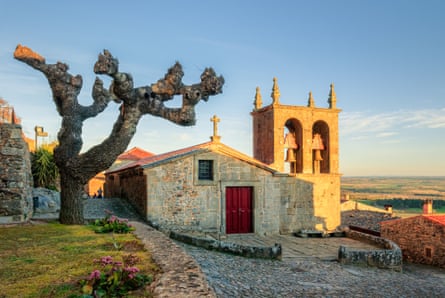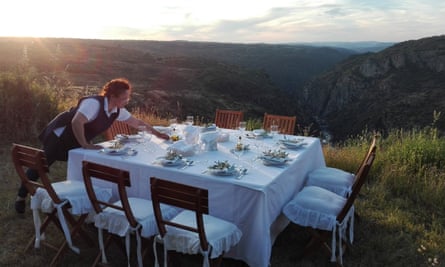
The feeling of awe that being in the company of wild or semi-wild horses elicits is hard to beat – and hard to come upon, too. Many of Europe’s wild horses are now extinct, though there are still semi-wild ponies on Exmoor and, in southern Bulgaria, the karakachan, an ancient breed related to the Mongol horse, roam the Rhodope hills near the town of Velingrad. In the breathtaking Greater Côa valley in northern Portugal, you can spend hours in the company of Sorraia, a breed of wild horses that feeds on dried undergrowth and scrub. Re-introduced by Rewilding Portugal, a nature conservation project founded in 2019, the Sorraia help prevent wildfires and increase bio-diversity, making the terrain more hospitable to roe deer, Iberian ibex, rabbit and red-legged partridge, which in turn benefits the Iberian wolf and Iberian lynx, eagles and vultures.
My son and I were among a small group of lucky eco-tourists who watched the Sorraia horses as they grazed while enjoying a prepared picnic of pasta, fresh salad and fruits in the Vale Carapito nature reserve. Leaning against a tree and observing these small, semi-wild horses, their coats the colour of dried grass, was a meditative, magical experience. It is one of several memorable nature tourism excursions available in the 120,000-hectare corridor that stretches from the Douro in the north, down to the Malcata mountains and nature reserve in central Portugal, close to the Spanish border.
Other regional treats for fans of slow tourism include watching vultures in a morning feeding frenzy from the comfort of a hide, bird watching and mountain biking through wetlands inhabited by re-introduced turtles, and tracking wolves – hot coffee, biscuits and binoculars all provided. Rewilding Portugal has teamed up with Wild Côa, a network of local sustainable-tourism and eco-businesses to provide excursions, guides and accommodation – often in remote areas, so book in advance. The Rewilding Centre itself is just outside the small town of Pinhel, near Guarda in central Portugal, where a few dormitory rooms are available. We stayed instead at the Casa da Cisterna, a boutique guesthouse in the fortified village of Castelo Rodrigo, with spectacular views from its terrace and the small pool.
After dinner, we piled into a 4×4 and, armed with torches, ventured into the Côa river valley in the Alto Douro, home to the Côa Valley Archaeological Park, a Unesco world heritage site and the world’s largest open-air Palaeolithic art site, discovered during excavations for a proposed dam in the early 1990s. Bats flew overhead as our guide helped us decipher the panels of rock carvings our forebears used to decorate their landscape, including an auroch (a chunkier ancestor of domestic cattle), horses and an ibex shown to be looking backwards and forwards – a rare instance of movement being rendered in this ancient art form.

Watching vultures devouring a raw breakfast offered a spectacle of a very different kind. Secreted inside a hide in the Faia Brava reserve, situated on either side of the Côa river, we waited, in silence, for half an hour. Flies gathered and then, suddenly, the sky filled as an endangered Eurasian griffon vulture and smaller Egyptian vultures, followed by red kites, swooped in on the carrion laid out on rocks right in front of us. Brave Iberian magpies and ravens snuck in where they could. It was thrilling viewing.
The next day we enjoyed bird watching and a gentle mountain bike ride in the restored wetlands of Paul de Toirões. A few days later, we hiked up the medieval Calçada de Alpajares trail that winds through the dramatic Ribeira do Mosteiro valley in the Douro International Natural Park. It leads up to Castro de São Paulo, a bronze age settlement affording biblical views. Golden eagles flew overhead.

Our last evening was spent in Rio de Onor, a village that time forgot in the Montesinho Natural Park. One of the Seven Wonders of Portugal, this rural gem is spliced by the border with Spain. We stayed on the Portuguese side, in the unmissable Casa de Ana guesthouse, whose traditional wooden balcony overlooks the river.
Our host, Dona Rita, ate with us in the wood-panelled dining room, rounding off the hearty fish dinner with her homemade brandy. She ushered us out at dawn to track Iberian wolves, whose coexistence with humans, farmers and livestock Rewilding Portugal is seeking to promote. Perched beneath a canopy, we scoped the granite landscape with binoculars. The sun rose, warming our faces, and hope grew, but we weren’t in luck.
Later that morning, we knew from the paw prints and fresh scat on the trails that our lupine friends weren’t far away. This was a heartening reminder that the Côa corridor is home to migrating wildlife, just as it was when those ancient rock carvings were made all those centuries ago – just on a much smaller scale. Getting up close with some of its inhabitants as a nature tourist was an unforgettable privilege. Wolves, I will be back.
For information on dormitories (from €35) and for excursions, go to rewilding-portugal.com. Rooms at Casa da Cisterna from €80
Nature trails – three more adventures
Hidden Highlands Enjoy guided rewilding walks, nursery tours,
self-guided hikes and wildlife encounters at Dundreggan’s Rewilding Centre, a 10,000-acre estate in the Scottish Highlands. Dundreggan Rewilding Centre, Glenmoriston, Inverness. B&B from £125 for a double room (visitdundreggan.co.uk).
On a wing and a prayer Go butterfly and moth-watching with celebrated expert guides, such as Patrick Barkham and Tristan Lafranchis, in destinations ranging from the UK, Greece, Slovenia and Spain to Honduras, South Africa and Sri Lanka with Greenwings (greenwings.co).
Forest treasures Track wolves, follow moose and eat supper by a campfire in Bergslagen forest, Skinnskatteberg, two hours from Stockholm. A night-time lake cruise to spot beavers, bats and birds, trekking, wild swimming and canoeing also part of this five-day trip (£1,493, responsibletravel.com).



